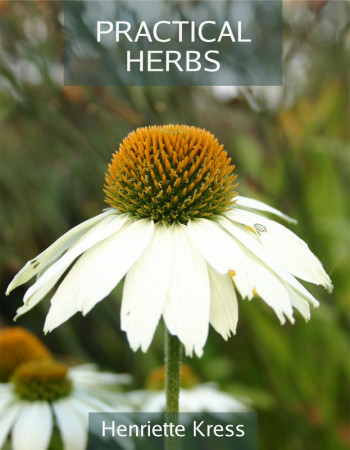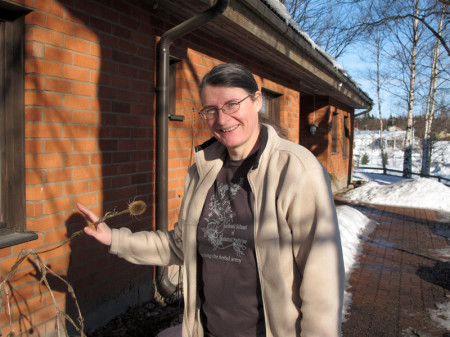
Plant lovers who like free online info might already know the voice of Henriette Kress, an herbalist and herbal teacher based in Finland who has hosted the multilingual website, Henriette’s Herbal, since 1995. It is one of the oldest—and quite possibly the largest—of the herbal websites out there.
A person can get lost reading at Henriette’s Herbal, with essay after essay by Kress and others. The herbal and culinary FAQs alone are troves of useful information, collaborated upon by many, and succinctly delivered. Whenever Kress makes an appearance, there is that distinctive voice with its “gentle wit,” as one writer described it, signed simply, “Henriette.”
For those willing to get lost for days—or months—the tech savvy Kress offers the entire site (a 2.3 GB data disk including 80,102 files) in DVD form for $25.
But for everybody else there is Practical Herbs—her 150-page full-color guide to using medicinal plants, available in English, Swedish, and Finnish, now with a Japanese translation under consideration.
Practical Herbs is ideal for the entry-level herbalist. It starts with an ample how-to section that’s easily read and navigated, covering “The Basics” such as picking herbs, drying herbs, making and using herbal teas, herbal oils and salves, tinctures, herbal vinegar, and herbal syrups.
Safety and sustainability are also addressed in this section, with simple tips like:
“Don’t pick large quantities of an herb you’ve finally located after years of searching. Instead pluck a twig, a flower, and a leaf, and take those home with you. Then double-check what you wanted the plant for, and which part of the plant you should gather for that purpose. Once you’ve identified a plant in the wild, you’ll spot it more easily in the future.”
She warns to avoid plants growing near stables, pastures, and outhouses, which “can host an abundance of gut bacteria—essential for digestion but not all that healthful to digest!,” with the added point that “with so much fertilizer about, any plants that accumulate nitrates will certainly have done so!”
And cleanup after plant picking, Kress writes, should involve discarding “stems and the like” under nearby foliage so as not to make a mess of nature.
After “The Basics” follow 23 accounts of specific plants, including but not limited to angelica, beggarticks, black currant, calendula, California poppy, chickweed, cleavers, coneflowers, dandelion, horsetail, rose, stinging nettle, St. John’s wort, vervain, willowherb (fireweed), and yellow dock (curly dock). Each plant account contains information on classification, description, best time to harvest, lookalikes, important constituents, picking and processing, effects and uses, recipes for herbal remedies, warnings, safety for children and pregnant women, and also food uses—which is of course right up my alley.
Interspersed with the plant accounts are informational sidebars on plant families, herbal remedies for various ailments, and recipes.
Among the specific herbal remedies she includes are a gardener’s salve, “good for painful muscles and dirt-roughened skin,” that combines oils from either meadowsweet (Filipendula ulmaria) or balsam poplar buds, and calendula flowers or plantain (Plantago) leaves. And there’s a warming salve “useful for where winters (and feet) are cold”—perfect for me, as I live in a town nicknamed Brecken“Fridge” for its biting winters—and a cinquefoil paste for inflamed cuticles that a chronic nail-biter like yours truly desperately needs.
For teething babies, she recommends dipping a cloth into chamomile tea and freezing it, “then give it to baby to chew on.” And “if your child itches all over with chickenpox,” she writes, “gently wash the skin with a cooled chickweed tea or soothing chickweed (Stellaria media) ice cubes several times a day.” There’s also a recipe for a wild green smoothie—not to be drunk every day ad infinitum—but for a couple weeks as a spring tonic.

Kress is a practicing herbalist, which means, she explains at Henriette’s Herbal, “I correct imbalances, using herbs in combination with diet and lifestyle changes. An herbalist can probably help you if you’re feeling tired all the time, have digestive or sinus troubles, if you have recurring infections (like, for instance, cystitis), if your period’s too long, short, crampy or just too much, if you can’t sleep, and even if you get the flu too often to suit you. Small uncomfortable things like that, which doctors usually can’t do much about.” She does not consult with clients via email, so for folks seeking an herbalist, she recommends checking bulletin boards at health food stores, co-ops, or vegetarian restaurants to find a local practitioner. “And in Helsinki?” she writes, “There’s me.”
The vision for Practical Herbs was bigger than one woman’s practice, however. It was “to bring herbs to the masses,” she said. “To show just how easy they’re to pick and use, and how effective they are for a variety of problems. To get people to understand how easy it is to make salves, tinctures and so on—including potential trouble spots and how to avoid them.”
Practical Herbs does well for that purpose. It makes for a great herbal textbook—easy to follow, with readable text and color-coded folios for page numbers and section names. The plants are in alphabetical order by common name, and the index is by common name, scientific name, herbal use, and preparation.
Beyond beginners, experienced herbalists are likely to appreciate so many good ideas packed into this tight, handy volume.
Herb Nuts Collaborate
Kress graduated from Helsinki University of Economics in 1991 and worked first in logistics and later as a finance manager for “the local branch of a huge multinational” before leaving the position in 1998 to study under the U.S.-based Michael Moore at the Southwest School of Botanical Medicine.
Today, she uses Moore’s intake form for almost all of her clients, with the exception of those with very straightforward problems. She combines his system with information on lifestyle problems (problem foods and nutrient deficiencies, for example) from Paul Bergner and humoral theory from Christopher Hedley.
“The combination of these works exceedingly well,” Kress said of the teachings underlying her herbal practice.
Have Your Herbal Wisdom and Eat It Too
Those inclined to eat their herbs are not to feel left out, since Kress includes a section on food uses for each of the plants described in Practical Herbs. I was inspired by the recipes and culinary uses of plants or plant parts unfamiliar to me.
On currants, for example, Kress writes that those with scented leaves—in her case the black currant Ribes nigrum, which bears an edible berry widely used in Europe for juice—also bears edible leaves.
“Alternate leaf-gathering years with berry-picking ones, according to the rhythm of the plant,” Kress writes of Ribes. “Pick leaves when flowers and berries are less abundant and when leaf growth is lusher.” This is such a good point—and so widely applicable. If rosehips aren’t in season one year, for example, it doesn’t merit searching far and wide to strip nature of her every last fruit. Instead, something else is likely to be plentiful in a given season. There can always be rosehips another year.
Herbal Computerista
Kress is currently working to finalize her 168-page sequel, Practical Herbs 2. It contains instructions for making herbal honey, herbal sugar, green powder, herbal salt, and herbal compresses and wraps; short recaps on herbal syrups, oils and salves; and another set of herbs including thyme, horse chestnut, elecampane, chamomile, juniper, catnip, goldenrod, ground ivy, mallows, true mints, hawthorn, willows, plantains, sage, lemon balm, burdock, mullein, garlic, valerian, and horsemints. There are remedies for menstrual problems, post-partum depression, infertility, migraines, digestive problems, small wounds, bruises, and hemorrhoids “with picture!” she writes, and some blurbs on the medicinal uses of cucumber, onion, celeriac, cabbage and potatoes.
She and her books can be found online at www.henriettesherbal.com or Facebook. There are Kindle, PDF, and print versions available.
If you’re looking for a practical guide to using herbs medicinally that is broadly applicable, Practical Herbs and its sequel are unlikely to disappoint.

READ MORE: This blog post is excerpted from a longer review of Practical Herbs, along with an author interview, that came out in the October 2013 edition of the Wild Edible Notebook. The Notebook is a monthly magazine, now available in the Apple Newsstand for iPad and iPhone (the app is free and there’s a free issue, then it’s $1.99/month after that), or in various PDF formats including an 8.5″ x 14″ print-and-fold booklet, a screen-reader, and a tall, skinny one designed for Android readers. The $1.99/month subscription supports the ongoing development of the publication and its many digital formats. For more info, click through to the Wild Edible Notebook. Thanks SO much for considering supporting this project. -WFG

Leave a Reply